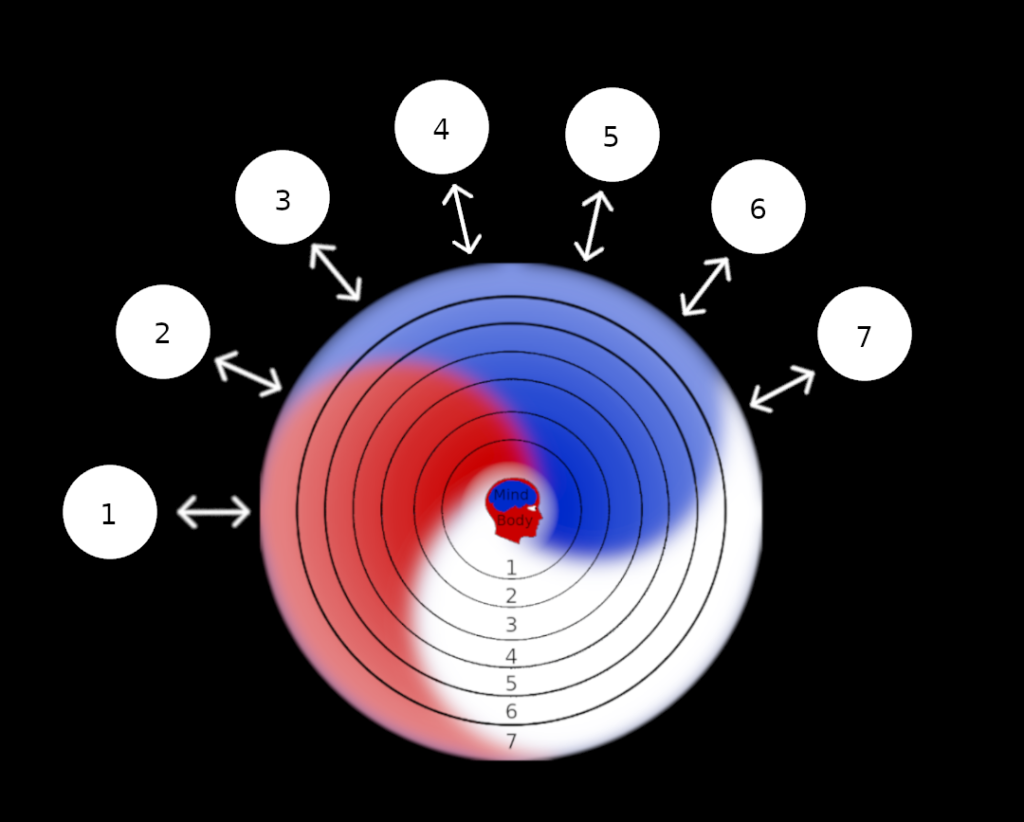7 spheres x3 aspects = 21 sections x7 domains = 147 zones

The 7 Spheres of Integration (center, above) are shown divided (by color) into the 3 aspects of the human (Blue=mind, Red=Body, White=Spirit). The 7 Spheres are labeled numerically: 1. Independent Integration/ yourself, 2. Family/Home, 3. Business/Professional, 4. Local/Community, 5. National/Country, 6. World/Global, & 7. Beyond. These 7 Spheres of Integration multiplied by the 3 Aspects of the human, mind, body and spirit, create 21 separate plotting possibilities. These 21 separate areas can be specified according to the sphere # (1-7), followed by the aspect letter (M,B, or S). Additionally then, the domain of study (shown as orbiting discs of light) being applied would be noted following the M, B, or S, simply with it’s corresponding number: 1. Law, 2. Psychology, 3. Biology & applicable sciences, 4. Human Factors Engineering, 5. Environmental and Occupational Safety & Health, 6. Manpower, Personnel and Training, & 7. Survivability & Habitability. the business/professional sphere, in the mental aspect, and in light of Manpower, Training, and Personnel. By dividing the 21 sections each into 7 zones according to the domains of study, there is a total of 147 zones that are used in the XSE functional analysis.
*Even though not every zone will apply to every SOI, it is beneficial in analysis to brainstorm “how could it apply?” This not only provides for an excellent mental workout in the field of critical and creative thinking, but likewise, it is often the introduction to a new view or realization that otherwise would not have slipped past the systems engineer without their awareness.

Example: Developing a Software Program
For example in XSE functional analysis, if a systems engineer of a new software program told you that they were currently analyzing zone 3M6, then you would know that the program was currently being studied in relation to the business/professional sphere (how might this new program integrate and change the business/professional landscape), and in particular, how the mental aspect of the people involved might be influenced (i.e. will it require them to possess more or less intellectual capacity, or could it possibly automate things so much that there may be drawbacks, such as employees losing touch with the purpose and functions of business operations). Looking at the last number in the 3M6 example, you know that the domain of Manpower, Personnel and Training is being applied to the analysis, which sheds light on questions such as “What new training will need to occur with my staff? What new people might I need to hire? How many?” Keep in mind that if the software program is going to be eliminating some of the work already done by some employees, instead of losing any personnel from your staff, this may be a good time to set them in positions to advance and expand your company.

